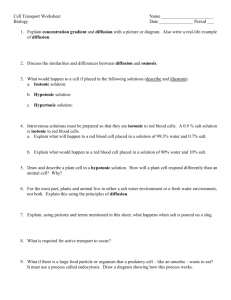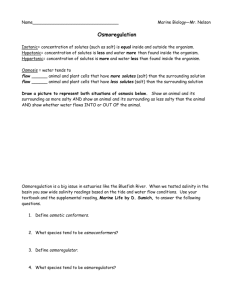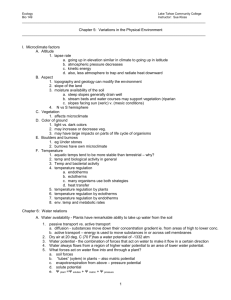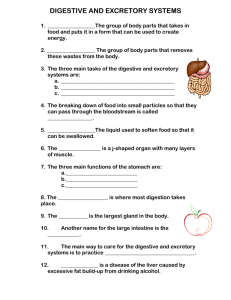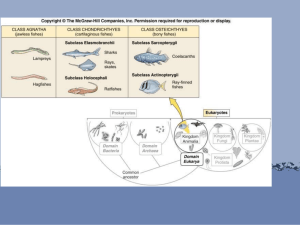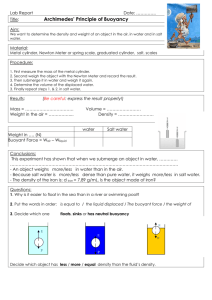The Excretory System
advertisement
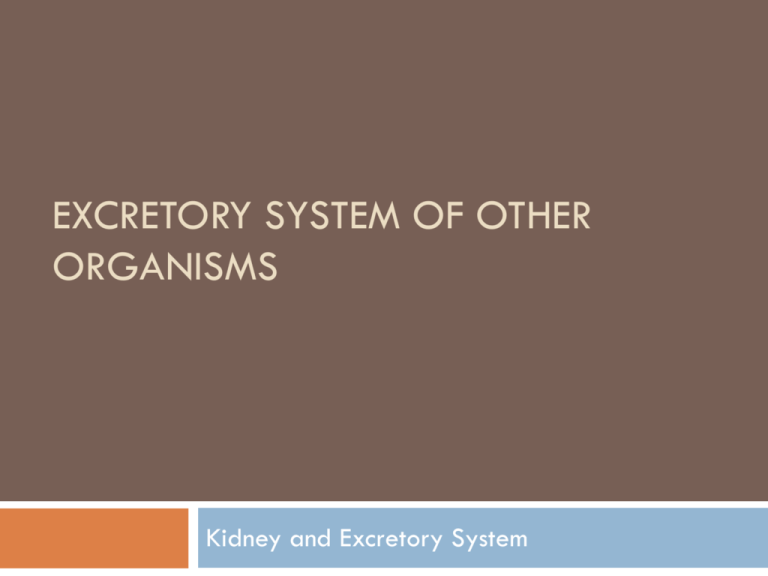
EXCRETORY SYSTEM OF OTHER ORGANISMS Kidney and Excretory System WATER BALANCE Isotonic Animals Marine Bony Fish Freshwater Bony Fish Birds and reptiles near the sea Sea mammals Terrestrial animals Isotonic Animals The concentration of solutes in isotonic animals is approximately equal to that of their environment. So, they do not gain or lose water Only marine invertebrates and cartilaginous fish (sharks) are isotonic The concentration of solutes in the tissues of isotonic animals is approximately equal to that of the ocean. This is 100 times higher than that found in the mammalian bodies. The high concentration of solutes in chondrichthyes is due mostly to the presence of urea Marine Bony Fish The rate of water loss is high in marine bony fish Why? They drink water (seawater) at a rate of approx. 1% of their body weight/hour What about all the salt? Specialized cells in the gills excrete excess salt Freshwater Bony Fish Freshwater bony fish tend to gain water from their environment due to osmosis They produce large quantities of dilute urine (approx. 1/3 of their body weight/day) and do not drink water Salt? Salt-absorbing cells in the gills use active transport (energy is require) to pump salts into their body Birds and reptiles (near the sea) Birds and reptiles living near the sea consume a large amount of salt in their diet. Nasal salt glands remove their excess salt form their body by secreting a concentration salt solution Sea Mammals The kidneys of sea smalls (seals, whales, porpoises) are able to maintain a constant salt concentration in their bodies by producing urine that has a high concentration of salt They are able to drink seawater because the salt concentration of their urine is higher than that of sea water Terrestrial animals Most terrestrial animals drink water, some do not Metabolic water produced form cellular respiration may be sufficient to meet the needs of some animals Terrestrial animals Ex. Kangaroo Rat Southwestern US Never has to drink Water comes from: metabolic water released during cellular respiration water present in their food Behaviour Emerge from burrows only at night (air is cooler and more humid). Helps prevent water loss from their bodies and reduce the need to sweat to keep cool Avoid movement in their burrow – minimizes heat production, therefore, no sweating Terrestrial animals Ex. Kangaroo Rat Dry food stored in their burrows absorbs moisture lost in breathing – eaten back Physical adaptations Noses become cooled during inhalation as a result of evaporating water but the cooled membranes cause the moisture to condense during exhalation Large intestine absorbs almost all water present in the digestive tract. Feces are dry, hard pellets Kidneys conserve water by excreting concentration urine ORGANS OF EXCRETION Contractile vacuoles Flame cells, Protonephridia Earthworms Malpighian Tubules Planarians Nephridia Paramecium Insects Kidneys Vertebrates Contractile vacuoles Paramecium Protozoans and sponges Lack complex excretory system Contractile Depends vacuoles excrete water and solutes on ambient osmotic conditions – contracts more frequently and expels more water in fresh water Flame cells, Protonephridia Planarians Have two protonephridia composed of branched tubules that empty wastes through excretory pores on their surface The protonephridia contains numerous bulblike flame cells with clustered, beating cilia that propel fluid into the tubules These structures function in waste excretion and osmotic regulation Nephridia Earthworms Have two nephridia in almost all of their body segments Each nephridium contists of a tubule with ciliated opening on one end and an excretory pore that opens to the outside of the body at the other end Fluid is moved in by cilia Some substances and water are reabsorbed in a network of capillaries that surround the tubule This system produces large amount of urine (60% of body weight/day) Malpighian Tubules Insects They collect water and uric acid from surrounding hemolymph (blood) and empty it into the gut. Water and useful materials are reabsorbed by the intestine but wastes remain in the intestine Videos CrashCourse Insect (grasshopper) https://www.youtube.com/watch?v=5IdSruWQG5k Handouts Excretory system (of other organism – not online) Flatworm/grasshopper (not online) Review handouts
